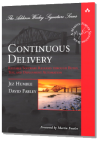Who does CD?
Continuous Delivery at Wix.com

At Wix.com you can easily create your own web site both for professional and personal use. Aviran Mordo is the head of back-end engineering at Wix and is a Continuous Delivery expert. He has published this awesome article on how Wix.com manages to do continuous delivery of their software. Link to article at avriansplace.com or in read it in PDF format with marked highlights.

Continuous Delivery at Etsy
A really nice presentation by Mike Brittain about how Etsy manages to deploy code to production. They do this on average 30 times a day!
This PDF is a summary of what Mike says during this 48 minute session.
More from engineers at Etsy
Wil Stuckey explains how Etsy manages to deploy nearly ~10,000 changes in one year, and how they run A/B experiments in the midst of continual code change. See presentation on InfoQ >>
Erik Kastner and John Goulah from Etsy talk about their life as engineers at Etsy.

Summary
Jez Humble explains Continuous Delivery.
Further reading
Jez together with David Farley is an author of this really good book about CD. If you are going to dig deeper into CD this is the book to read!
Further seeing
Another good discussion with Jez and Martin Fowler about CD and its challenges.

From idea to production
Robert Johnson discusses Facebook's approach to scalability issues resulting from a large growth of the user base. He talks about: why one needs to prepare for horizontal and not vertical scalability, very short release cycles which are better because they introduce fewer bugs, the need to streamline the deploying process for short release cycles, and making the entire process faster every day.

Summary
This short presentation from Kevin Scott is about how LinkedIn stopped all development of new features to focus on migrating to Continuous Delivery during the end of 2011.
Shifting from feature-branch-based development to the new continuous deployment system required halting all development for (only) two months as LinkedIn trained staff, migrated old code, and built out the automated tools it needed to make the new system work. Scott says: "We wanted to be at the point where... as soon as they were checking in their code... it was qualified and releasable... that anything sitting in trunk must be releasable at any point in time, and if it's not releasable it's just as significant as a site emergency. Stop all forward software development and everyone is all hands on deck to get trunk fixed."
Further reading
A good article about LikedIn's journey to CD: The Software Revolution Behind LinkedIn's Gushing Profits
Perforce recommending Continuous Delivery

Five Tips for Practicing Continuous Delivery
A short article from Perforce with five recommendations to achieve CD.
Also Perforce has decided to also move to Continuous Delivery. Read about why?

Hacking Culture
Jesse Robbins shares his findings in doing cultural changes to move towards a more agile way of doing software development.
Quote from Jesse
Because you are able to change faster, the specification you wrote a long time ago has a lot less to do with what's in production now. And that is probably a good thing because you are delivering value.

Explaining Agile
Next time you (again) find yourself failing in your predictive planning, see the first 14 minutes of this clip. See it twice. Martin Fowler explains why this almost always happens.
But is failing a plan a measure of bad success? Changing a plan could be the best for the customer. And that is what matters, right? So, stop predicting what is best to do tomorrow and definitely what is best to do next week - Be Agile.
Fred George - Programmer Anarchy
The Agile movement shifted the relationship between clients and developers in a profound way. In waterfall processes, clients specified large amounts of functionality, then nervously faded into the background until the fateful day-of-delivery. With Agile, developers strove to engage with clients continuously, and delivered much more frequently against their needs.
The trust of the clients in developers evolves into a broader trust of the developers to deliver business value without resorting to a series of well-defined stories. In essence, the business has empowered the developers to do what they think is right for the business. This model, popularized by Facebook, has several labels, but the one we prefer for our flavor is Programmer Anarchy.
The Best Process Is No Process
In 2012, the Wikispeed team took the world by storm. They took agile practices and applied them to the stodgiest industry possible: the car industry. They developed a green car in 3 months, proving that cars don't need to be developed in 10-25 year product cycles.
The main point of this awesone article is to replace process with software where it's possible and where it makes sense, i.e. to reduce process debt. Link to article at InfoQ >>

Release More Frequently
Andy Singleton explains why and how Assembla has moved to Continuous Delivery. Andy has also made an awesome e-book about CD available on ContinuousAgile.com.
Release more frequently is their master plan!
The first 25 minutes is the presentation. The rest is questions and discussions.

Adopting Continuous Delivery
A great talk from Jez Humble about Continuous Delivery.




